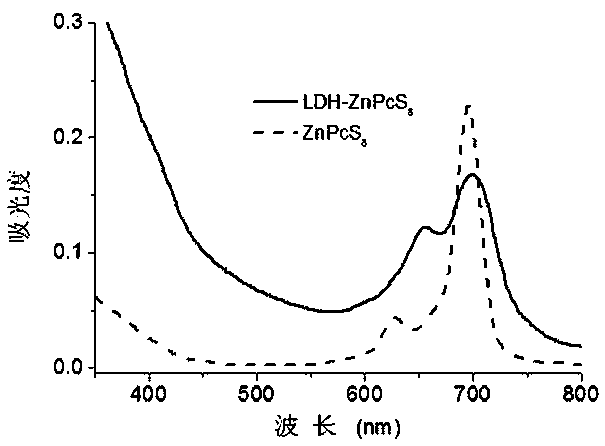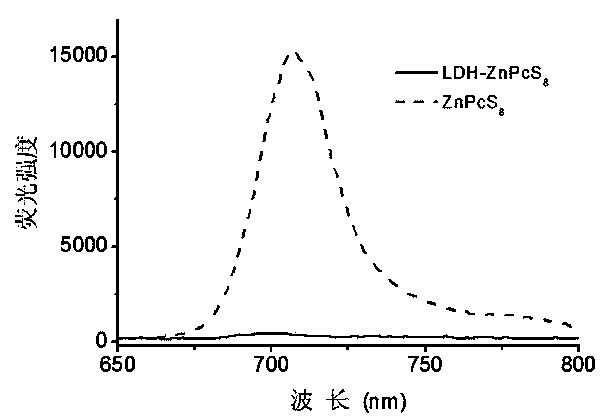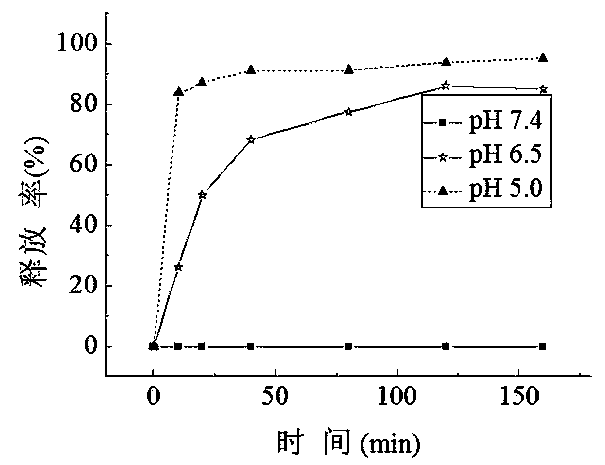Phthalocyanine-hydrotalcite complex and preparation method and application thereof
The technology of hydrotalcite and composite is applied in the field of phthalocyanine-hydrotalcite composite photosensitizer and its preparation, and achieves the effects of strong ability to penetrate biological membranes, high biocompatibility and easy industrialization
- Summary
- Abstract
- Description
- Claims
- Application Information
AI Technical Summary
Problems solved by technology
Method used
Image
Examples
preparation example Construction
[0042] The preparation method of phthalocyanine-hydrotalcite compound of the present invention comprises the following steps:
[0043] Prepare aqueous solutions containing divalent metal salts and trivalent metal salts, lye (sodium hydroxide or potassium hydroxide aqueous solution), and phthalocyanine aqueous solution. Under the protection of nitrogen, slowly add metal salt solution and lye dropwise to the phthalocyanine aqueous solution, and stir at 15~30°C for 0.5~2h. Afterwards, the temperature was raised to 50~70°C, and the stirring reaction was continued for 1~3h. After the crude product is centrifuged, washed and hydrothermally treated, a phthalocyanine-hydrotalcite complex can be obtained.
[0044] In the above reaction, in the metal salt aqueous solution, the concentration of divalent metal ions is 0.1~0.5 mol / L, and the concentration of trivalent metal ions is 0.025~0.25 mol / L; in the lye, the concentration of hydroxide is 0.1~2 mol / L; in the phthalocyanine aqueous...
Embodiment 1
[0051] Synthesis and Physicochemical Properties of Zinc Tetra-a-(6,8-disulfo-2-naphthyloxy)phthalocyanine
[0052]
[0053] Formula 1)
[0054] This compound can also be called 1,8(11), 15(18), 22(25)-tetrakis(6,8-disulfonic acid group-2-naphthyloxy)zinc phthalocyanine, and its structure is as formula (1 ), where:
[0055] .
[0056] (1) Preparation of 3-(6,8-disulfonic acid-2-naphthyloxy) phthalonitrile dipotassium salt: with 3-nitrophthalonitrile (5 mmol) and 2-naphthol-6, Dipotassium 8-disulfonate (5~7.5mmol, preferably 5mmol) was used as reactant, dimethyl sulfoxide (10~25mL, preferably 10mL) was used as solvent, in potassium carbonate (7.5~15mmol, preferably 10mmol), divided into three In the presence of batch addition) and nitrogen protection, the reaction was stirred at room temperature to 45°C (preferably 45°C) for 48 to 96 hours, monitored by thin-layer chromatography, and the reaction was terminated when 3-nitrophthalonitrile was basically consumed. Filter t...
Embodiment 2
[0061] Synthesis and Physicochemical Properties of Zinc Tetra-a-(4-sulfo-phenoxy)phthalocyanine
[0062] This compound can also be called 1,8(11), 15(18), 22(25)-tetrakis(4-sulfonic acid group-phenoxy)zinc phthalocyanine, and its structure is shown in formula (1), wherein :
[0063] .
[0064] (1) Preparation of 3-(4-sulfonic acid-phenoxy) phthalonitrile sodium salt: 3-nitrophthalonitrile (5mmol) and 4-hydroxybenzenesulfonate sodium (5~7.5 mmol, Preferably 5mmol) as the reactant, dimethyl sulfoxide (10~25mL, preferably 10mL) as the solvent, in the presence of potassium carbonate (7.5~15mmol, preferably 10mmol, added in three batches) and under nitrogen protection, at room temperature~45°C Stir the reaction at 45°C (preferably 45°C) for 48-96 hours, monitor by thin-layer chromatography, terminate the reaction when the 3-nitrophthalonitrile is basically consumed, remove the insoluble matter by suction filtration after the reaction, add 30ml ice chloroform to the filtrate , ...
PUM
 Login to View More
Login to View More Abstract
Description
Claims
Application Information
 Login to View More
Login to View More - R&D
- Intellectual Property
- Life Sciences
- Materials
- Tech Scout
- Unparalleled Data Quality
- Higher Quality Content
- 60% Fewer Hallucinations
Browse by: Latest US Patents, China's latest patents, Technical Efficacy Thesaurus, Application Domain, Technology Topic, Popular Technical Reports.
© 2025 PatSnap. All rights reserved.Legal|Privacy policy|Modern Slavery Act Transparency Statement|Sitemap|About US| Contact US: help@patsnap.com



